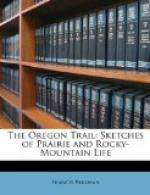Closer and closer the rocks gathered round us, growing taller and steeper, and pressing more and more upon our path. We entered at length a defile which I never had seen rivaled. The mountain was cracked from top to bottom, and we were creeping along the bottom of the fissure, in dampness and gloom, with the clink of hoofs on the loose shingly rocks, and the hoarse murmuring of a petulant brook which kept us company. Sometimes the water, foaming among the stones, overspread the whole narrow passage; sometimes, withdrawing to one side, it gave us room to pass dry-shod. Looking up, we could see a narrow ribbon of bright blue sky between the dark edges of the opposing cliffs. This did not last long. The passage soon widened, and sunbeams found their way down, flashing upon the black waters. The defile would spread out to many rods in width; bushes, trees, and flowers would spring by the side of the brook; the cliffs would be feathered with shrubbery, that clung in every crevice, and fringed with trees, that grew along their sunny edges. Then we would be moving again in the darkness. The passage seemed about four miles long, and before we reached the end of it, the unshod hoofs of our animals were lamentably broken, and their legs cut by the sharp stones. Issuing from the mountain we found another plain. All around it stood a circle of lofty precipices, that seemed the impersonation of silence and solitude. Here again the Indians had encamped, as well they might, after passing with their women, children and horses through the gulf behind us. In one day we had made a journey which had cost them three to accomplish.
The only outlet to this amphitheater lay over a hill some two hundred feet high, up which we moved with difficulty. Looking from the top, we saw that at last we were free of the mountains. The prairie spread before us, but so wild and broken that the view was everywhere obstructed. Far on our left one tall hill swelled up against the sky, on the smooth, pale green surface of which four slowly moving black specks were discernible. They were evidently buffalo, and we hailed the sight as a good augury; for where the buffalo were, there too the Indians would probably be found. We hoped on that very night to reach the village. We were anxious to do so for a double reason, wishing to bring our wearisome journey to an end, and knowing, moreover, that though to enter the village in broad daylight would be a perfectly safe experiment, yet to encamp in its vicinity would be dangerous. But as we rode on, the sun was sinking, and soon was within half an hour of the horizon. We ascended a hill and looked round us for a spot for our encampment. The prairie was like a turbulent ocean, suddenly congealed when its waves were at the highest, and it lay half in light and half in shadow, as the rich sunshine, yellow as gold, was pouring over it. The rough bushes of the wild sage were growing everywhere, its dull pale green overspreading hill




